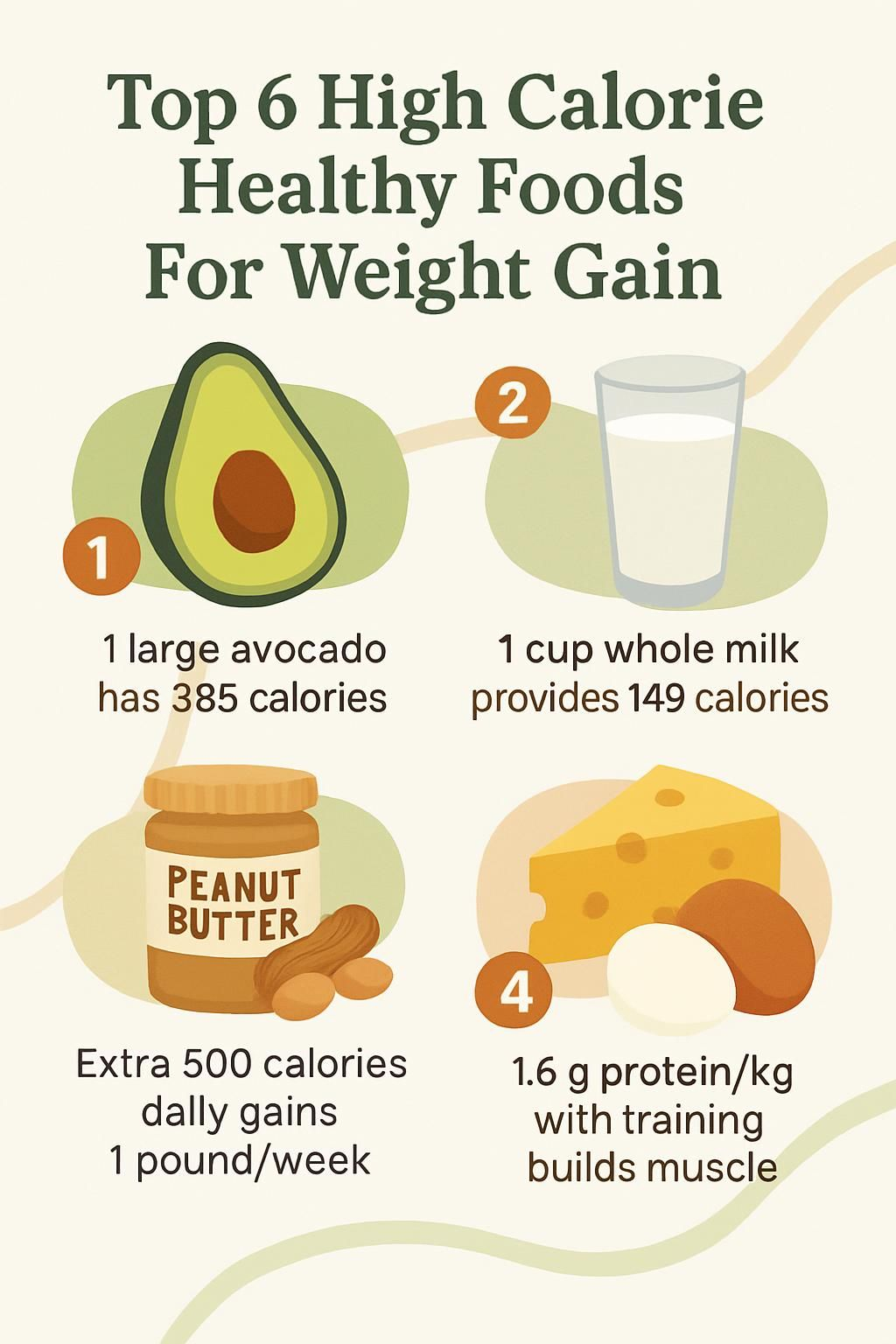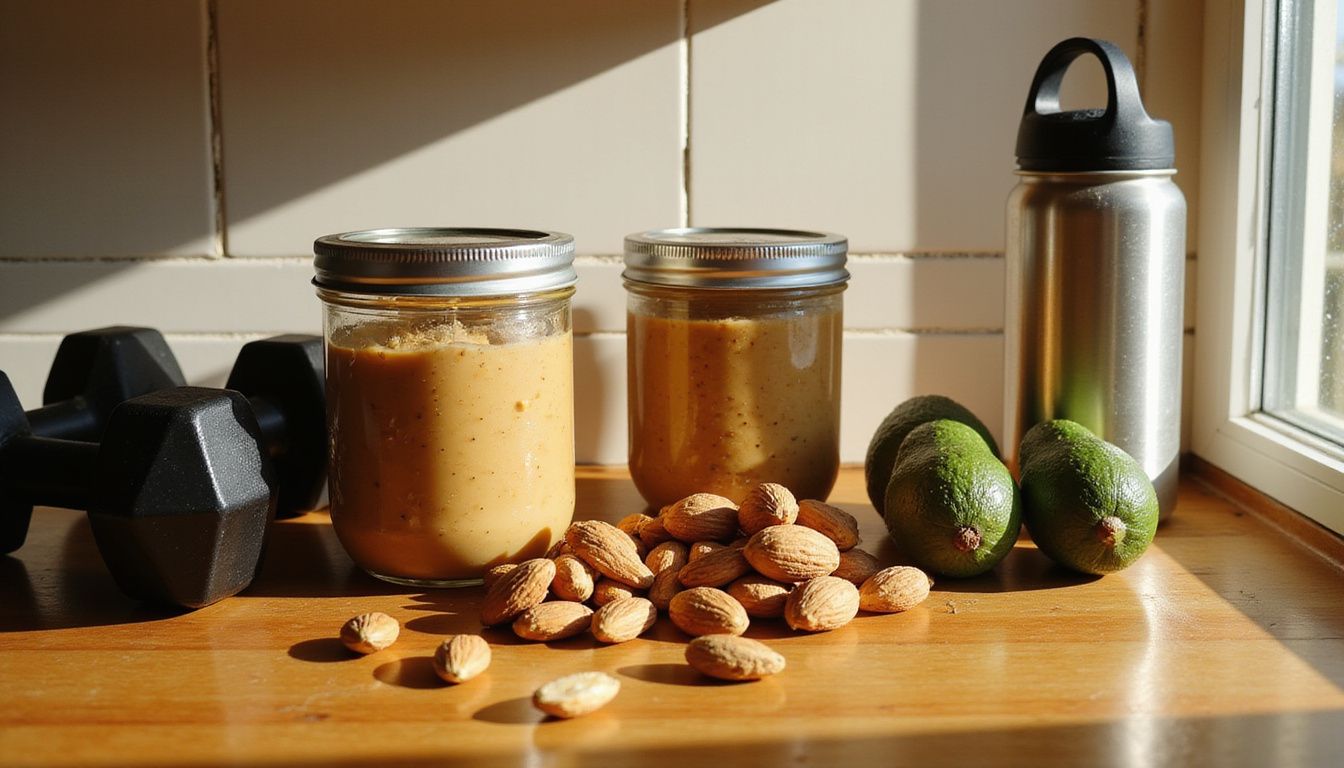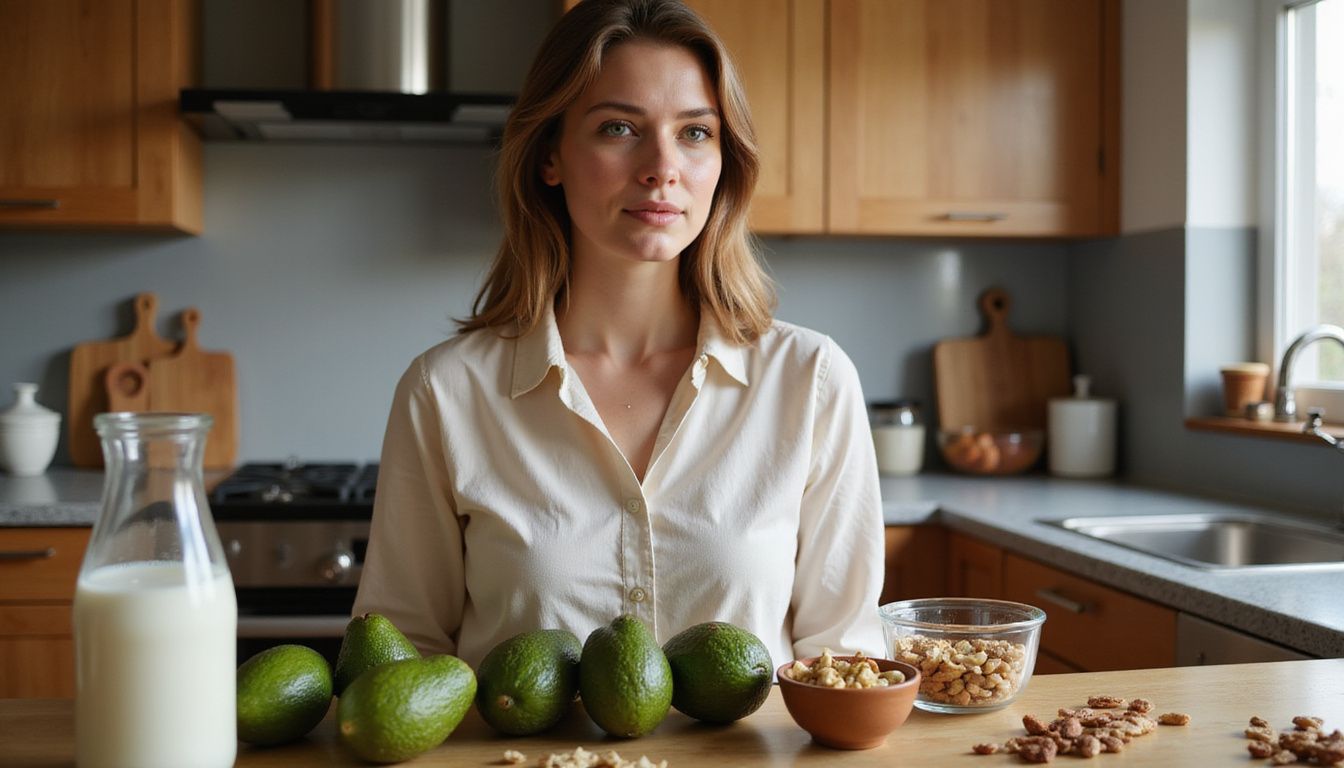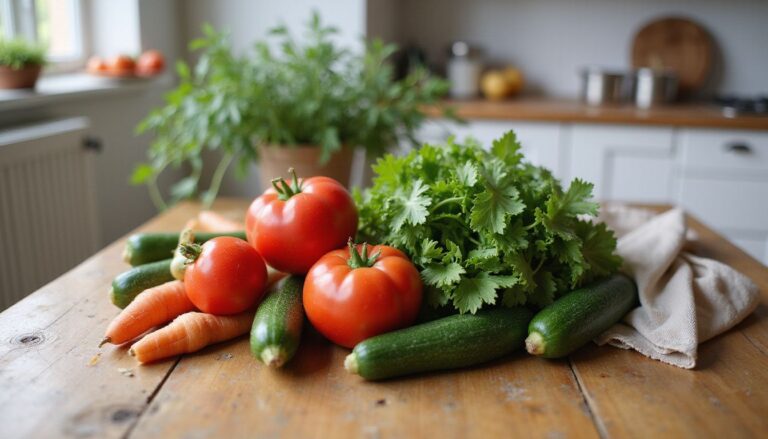Top 6 High Calorie Healthy Foods For Weight Gain
Our Nutrition Assistant AI Suite will transform your body. You will lose fat, get toned, and build muscle. Gain confidence and optimal health.
Gaining weight can be as challenging as losing it. I struggled to find high calorie foods that helped me gain weight without feeling stuffed or sluggish. After testing options like avocado, nuts, and whole milk, I researched what really works for steady, healthy weight gain.
This guide shares six foods to gain weight that deliver healthy calories and key nutrients. I also include simple ways to use them in meals and snacks so you can raise calorie intake without throwing off your healthy diet.
Key Takeaways
- High-calorie, nutrient-dense picks, such as avocados, nuts, whole milk dairy, salmon, potatoes, and whole grains, support healthy weight gain.
- One large avocado has about 365 calories and 30 grams of fat, a compact energy boost for any meal.
- Most people need about 500 extra calories per day to gain around 1 pound per week, according to the Academy of Nutrition and Dietetics (2020).
- Whole milk offers roughly 149 calories and 8 grams of protein per cup. A 5 to 6 ounce serving of Greek yogurt can provide about 150 to 165 calories with muscle-supporting protein.
- A 2022 review found at least 1.6 grams of protein per kilogram of body weight per day, paired with resistance training, increases lean muscle during weight gain.

Why Are High-Calorie Foods Important for Weight Gain?

High-calorie foods raise your daily energy intake so your body has a surplus. A calorie surplus means you eat more calories than you burn. That extra energy supports muscle growth and healthy weight gain.
Athletes often reach for peanut butter, full-fat dairy, and nuts because they pack calories into small portions. I saw the same effect. A spoon of olive oil or sliced avocado added to meals helped me hit targets without feeling too full.
Smaller, frequent meals that are nutrient-dense work better than simply making portions huge. Strength training then helps direct those calories to muscle instead of fat.
To gain one pound per week safely, most people need an extra 500 calories daily, says the Academy of Nutrition and Dietetics (2020).
What Should You Consider When Choosing High-Calorie Healthy Foods?
I focus on foods that deliver calories and nutrition in the same bite. Oily fish, whole milk products, whole grain bread, avocados, and nut butter provide a solid mix of protein, fats, carbohydrate, vitamins, and minerals.
I also scan labels for saturated fat and added sugar. Too much can raise LDL cholesterol or blood pressure over time. Choosing 100 percent nut butter, without added oils or sugar, gives protein and healthy fat with fewer extras.
Large health groups, including the American Cancer Society, advise limiting red meat and avoiding processed meat. I track calories from meals and snacks so I do not lean on cereal bars or puddings with lots of added sugar.
Simple swaps help. Plain Greek yogurt with whole grain cereal delivers filling carbs and protein at breakfast. Balancing food groups keeps carbohydrates and proteins steady while I raise calories in a safe way.
Top 6 High-Calorie Healthy Foods for Weight Gain
Avocados, nuts, full-fat dairy, salmon, potatoes, and whole grains are reliable high calorie foods. Each offers calorie-dense nutrition that fits into daily meals and snacks.
What Makes Avocados a Great Choice for Weight Gain?
Avocados are energy-dense and versatile. One large avocado provides about 365 calories, 30 grams of fat, and 17 grams of fiber. Even a quarter adds roughly 75 calories to a plate.
I add avocado to omelets, toast, tacos, and salads. It also works in guacamole, as a swap for mayo on sandwiches, or grilled with vegetables at dinner. The creamy texture boosts calories without a heavy feel.
When I used avocado at breakfast and lunch, I met my goals faster. It helped me increase healthy calories in small, tasty steps.
How Do Nuts and Nut Butter Help You Gain Weight?
Nuts and nut butter pack a lot of energy into small amounts. A quarter cup of raw almonds delivers about 170 calories, 6 grams of protein, and 15 grams of fat. A tablespoon of peanut butter adds about 95 calories to toast, oatmeal, or apple slices.
I blend nut butter into a banana smoothie with whole milk for an easy 250 to 300 extra calories. These foods support muscle hypertrophy, which means muscle growth, especially when paired with strength training.
Why Include Whole Milk and Full-Fat Dairy in Your Diet?
Whole milk ranks high on my list of foods to gain weight. One cup provides about 149 calories and 8 grams of protein. A 5 to 6 ounce cup of Greek yogurt lands around 150 to 165 calories with a strong protein punch.
These foods supply calcium and fat-soluble vitamins A, D, E, and K. I add cream cheese to toast, stir whole milk into smoothies, or pair yogurt with granola. It is an easy way to raise both calories and protein.
What Are the Benefits of Salmon and Oily Fish for Weight Gain?
Salmon is a two-in-one food, calories plus high-quality protein. A 3 ounce serving of wild Atlantic salmon has about 155 calories, 22 grams of protein, and 7 grams of fat. That supports energy and muscle building.
Oily fish provide omega-3 fatty acids, which are healthy fats that support heart and brain health. They may also help lower inflammation. I eat salmon at lunch or add canned tuna to sandwiches for variety and convenience.
How Do Potatoes and Sweet Potatoes Support Weight Gain?
Potatoes and sweet potatoes are rich in starch, a complex carbohydrate. Complex carbs digest more slowly and provide steady energy. One cup of cooked white rice has 204 calories and 44 grams of carbs, and potatoes pair well with it when I need more fuel.
Sweet potatoes bring fiber, potassium, and flavor. I top baked potatoes with cheese, olive oil, or sour cream to raise calories fast. These flexible sides fit many meals, like soup or steak.
Why Are Whole Grains Essential for Healthy Weight Gain?
Whole grains are a dependable source of carbohydrates. Whole grain bread gives fiber and extra calories that help me stay full. Granola can deliver 200 to 300 calories per half cup, so it is a quick way to raise energy.
I choose whole grain or seeded bread because it has more nutrients than refined bread. I also add dried fruit or dark chocolate to yogurt with granola for flavor and additional calories. These choices support exercise recovery and steady energy.
Benefits of Each Food
Each food below adds different nutrients that support healthy weight gain. I include a few data points so you can compare options at a glance.
Avocados: Which Nutrients Support Weight Gain?
Avocados supply healthy fats that raise calorie intake without large portions. One large avocado has around 30 grams of fat plus 17 grams of fiber. The fats help your body absorb vitamins and make meals more satisfying.
I mash avocado on toast, slice it into tacos, or stir it into macaroni and cheese for creaminess. The mix of fat and fiber helps steady energy between meals.
Nuts and Nut Butter: How Do They Provide Calories and Protein?
Nuts like almonds and peanuts give concentrated energy. A quarter cup of almonds supplies about 170 calories and 6 grams of protein. Two tablespoons of nut butter add around 190 calories to toast or oatmeal.
Nuts also deliver protein that helps limit muscle atrophy, which means muscle loss, during weight gain plans. I sprinkle nuts into cereal or snack on a small handful after strength training.
Whole Milk and Full-Fat Dairy: What Makes Them Nutrient-Dense?
Whole milk and plain full-fat yogurt offer calories, protein, and key micronutrients. A half cup of whole milk Greek yogurt gives about 165 calories and around 15 grams of protein, plus calcium for bone health.
Dairy proteins include casein and whey. Both support muscle repair. I prefer whole milk over many milk substitutes when I need more calories and protein per serving.
Salmon and Oily Fish: Why Are Omega-3s Important?
Omega-3s are essential fats your body cannot make. They support heart health and may improve cholesterol numbers when eaten regularly. Eating two servings of oily fish weekly is a smart target for most adults.
Salmon also provides complete protein, which contains all essential amino acids the body needs for muscle growth. I enjoy grilled salmon on toast or canned tuna mixed into a simple salad.
Potatoes and Sweet Potatoes: How Do They Supply Energy?
Potatoes and sweet potatoes refill glycogen, the stored form of carbohydrate in muscle. This supports training and daily activity. The fiber in sweet potatoes also helps keep blood sugar steadier.
These vegetables fit into many plates. I serve them with tuna, chicken, or beans to build a balanced, calorie-dense meal.
Whole Grains: What Essential Nutrients Do They Offer?
Whole grains bring B vitamins for energy metabolism and minerals like magnesium and iron. Oats, bran cereals, multigrain toast, and muesli supply fiber that supports digestion and fullness.
Some people enjoy sourdough made with whole grain flour. It can be a tasty way to add variety. I often pair whole grain toast with nut butter for a fast, nutrient-dense snack.
How Can You Add These Foods to Your Diet?
Small upgrades at each meal help you reach calorie goals without discomfort. Here are easy ways I use daily.
How to Boost Breakfasts with High-Calorie Foods
- Add granola over Greek yogurt or oatmeal to get 200 to 300 extra calories per serving.
- Top toast with avocado slices. One medium avocado supplies about 250 calories and healthy fats.
- Mix nuts and dried fruit into cereal or parfaits. Use at least a quarter cup of mixed nuts and dried fruit.
- Spread nut butter on whole grain toast. Two tablespoons give around 190 calories and extra protein.
- Drink smoothies made with whole milk, nut butter, and banana. One smoothie may contain 400 to 600 calories.
- Cook porridge with whole milk instead of water. This swap adds about 60 calories per cup.
- Sprinkle chia or ground flaxseed onto breakfast bowls for a quick calorie boost plus fiber.
What Are Easy Ways to Add Healthy Fats to Meals?
Healthy fats raise calories fast and add flavor. These ideas take only a minute or two.
- Drizzle 1 tablespoon of olive oil on salads, pasta, or grilled vegetables for about 120 extra calories.
- Melt a slice of cheese into eggs, soup, or sandwiches. Each slice can add about 100 calories.
- Top baked potatoes or steamed vegetables with butter or soft margarine. Each tablespoon offers around 100 calories.
- Spread nut butter on toast, crackers, or fruit. Two tablespoons supply more than 180 calories and some protein.
- Swap skim milk for whole milk in recipes to add creaminess. One cup gives almost 150 calories instead of fewer than 90.
- Add avocado slices to bowls and wraps. One whole avocado provides around 240 calories with beneficial fats.
- Sprinkle chopped nuts on cereal, yogurt, or salads. A small handful contains nearly 200 calories.
All rights reserved.
How to Prepare High-Calorie Snacks at Home
Homemade snacks help you control ingredients and raise calories with real food.
- Make granola bars with oats, nuts, honey, and dried fruit. Each bar offers about 150 to 200 calories.
- Prepare trail mix with a blend of nuts and dried fruit. Keep single-serve containers ready.
- Pair whole milk Greek yogurt with nut butter and granola for a protein-rich snack.
- Use full-fat dairy like cheese cubes or cottage cheese with fruit for an after-work boost.
- Blend smoothies with avocado, whole milk, banana, and peanut butter for quick calories.
- Spread almond or peanut butter on roasted or microwaved sweet potato slices.
- Top warm toast with mashed avocado and pumpkin seeds for healthy fats and crunch.
- Pack individual bags of trail mix or a wrapped granola bar to carry in your bag.
What Are Some Tasty High-Calorie Smoothie Ideas?
When mornings get busy, I rely on smoothies that pack calories, protein, and flavor.
- Chocolate Banana Nut Shake: 1 banana, 1 scoop chocolate whey protein, 1 tablespoon nut butter, and 2 cups dairy or soy milk. About 400 to 600 calories.
- Vanilla Berry Shake: 1 cup mixed berries, 1 cup Greek yogurt, 1 scoop vanilla whey, and 2 cups milk for a creamy, high-protein drink.
- Super Green Shake: 1 cup spinach, 1 avocado, 1 banana, 1 cup pineapple, 1 scoop whey, and 2 cups milk.
- Peanut Butter Oatmeal Smoothie: Peanut butter, cooked oats, whole milk, honey, and a scoop of protein powder for fiber and energy.
- Mango Coconut Protein Shake: Mango chunks with full-fat coconut milk and vanilla whey for a tropical, high-fat option.
- Strawberry Almond Smoothie: Strawberries, almond butter, and milk for natural sweetness and quality calories.
- Greek Yogurt Mocha Shake: Strong coffee, Greek yogurt, chocolate whey, ice, and a touch of sweetener for a wake-up shake.
I use these blends after workouts or on hectic days. They are an easy way to raise calorie intake without heavy chewing.
What Are Some High-Calorie Meal Ideas?
These simple meals help me add nutritious calories with minimal prep. Pick the parts that fit your taste and schedule.
Breakfast: How to Make Scrambled Eggs with Avocado and Nuts
I whisk two or three large eggs. Each egg has about 74 calories, so three give me more than 220 calories before add-ins. I scramble them until soft, then add half an avocado for creaminess, about 250 more calories.
I finish with chopped almonds or walnuts for crunch and extra fat. Even one tablespoon of nuts adds 50 to 60 calories. Cheese or a slice of turkey bacon can raise the calorie count further.
Lunch: How to Prepare Salmon with Sweet Potatoes and Veggies
For lunch, I pick salmon because 3 ounces provide around 155 calories and 22 grams of protein. I roast sweet potato wedges and steam broccoli or carrots for color and fiber.
Leftover salmon works cold in salads or flaked into sandwiches. It is a portable, high-calorie lunch that supports steady weight gain through the afternoon.
Dinner: What’s a Healthy Whole-Grain Pasta Recipe for Weight Gain?
Whole grain pasta gives fiber and steady energy. I toss cooked pasta with sautéed spinach, cherry tomatoes, and roasted peppers. Then I drizzle olive oil for about 120 extra calories per tablespoon and add shredded cheese for an additional 110 calories per ounce.
I use pesto or a light cream sauce when I need even more energy. This dinner keeps calories high with ingredients that also deliver vitamins and minerals.
Snacks: How to Combine Greek Yogurt with Granola and Nut Butter
I mix half a cup of whole milk Greek yogurt with half a cup of granola and one tablespoon of nut butter. The yogurt provides about 165 calories and 15 grams of protein. Granola adds 200 to 300 calories, and nut butter adds about 95 more.
This snack often crosses 450 calories and still tastes balanced. I choose plain or unsweetened options to keep added sugar in check.
What Common Mistakes Should You Avoid When Trying to Gain Weight?
Healthy weight gain takes planning. A few common pitfalls can slow your progress, but they are easy to fix.
Why Is Nutritional Balance Important for Weight Gain?
Balanced meals help you gain mostly muscle instead of extra body fat. Resistance training works best with enough protein, complex carbs, and healthy fats.
My strength improved faster when I paired calorie-dense foods like avocado and nut butter with lean protein at each meal. Balanced plates support recovery, energy, and progress toward your goals.
How Can Processed Foods Affect Your Weight Gain Goals?
Processed snacks often bring added sugars and low-quality fats. They can spike blood sugar without delivering good nutrition. Relying on them makes it harder to meet vitamin, mineral, and protein needs.
Choosing whole grains, natural nut butter, avocados, and full-fat dairy builds a stronger base for steady weight gain. Research consistently favors nutrient-dense choices over ultra-processed foods for better health outcomes.
Why Should You Pay Attention to Protein Intake?
Protein guides a calorie surplus toward muscle. A 2022 review of dozens of trials suggests at least 1.6 grams of protein per kilogram of body weight per day, alongside strength training, improves lean mass and lower body strength.
Whey, soy, egg, and pea protein can all work. I plan each meal around a clear protein source, then add carbs and fats to reach my target calories.
Conclusion
Choosing high-calorie healthy foods, such as avocados, nuts, whole milk, salmon, potatoes, and whole grains, makes it easier to gain weight and maintain health. These picks supply calories and protein along with important vitamins and minerals.
Adding them to my meals and snacks helped me reach calorie goals without feeling weighed down. Evidence from nutrition experts and public health sources, including the Harvard T. H. Chan School of Public Health, supports focusing on nutrient-dense foods during weight gain.
Health note: This article is educational and does not replace medical advice. If you have a medical condition, low appetite, or recent weight loss, talk with a registered dietitian or your healthcare provider for a plan that fits your needs.
FAQs
1. What are the top six high calorie healthy foods for weight gain?
The top six nutrient-dense foods that support healthy weight gain include avocados, nut butters, whole milk yogurt, salmon, quinoa, and dried fruits. Each food offers a balance of calories and essential nutrients.
2. How do these foods help with gaining weight in a healthy way?
These foods provide concentrated sources of energy from healthy fats, proteins, and complex carbohydrates. For example, avocados contain heart-healthy monounsaturated fats while salmon supplies protein and omega-3 fatty acids; both promote muscle growth rather than just fat accumulation.
3. Can you share nutritional values or data about these high calorie options?
Yes; for instance, one medium avocado contains about 240 calories and 22 grams of fat according to USDA data[1]. Two tablespoons of peanut butter offer around 190 calories with eight grams of protein[2]. Whole milk yogurt provides roughly 150 calories per cup along with calcium and probiotics[3].
4. Is it possible to add these foods into daily meals without feeling too full?
In my experience as a nutrition coach working with clients who struggle to increase their intake due to fullness or appetite issues, spreading smaller portions throughout the day works well. Adding sliced avocado on toast at breakfast or mixing nut butter into smoothies can boost caloric intake without overwhelming your stomach.
Summary: High calorie nutritious choices like avocados, nut butters, whole milk yogurt, salmon fillets, quinoa grains, and dried fruits deliver vital nutrients needed for steady weight gain when included thoughtfully in regular meals.
References:
[1] United States Department of Agriculture FoodData Central
[2] Harvard T.H. Chan School of Public Health
[3] National Institutes of Health Office of Dietary Supplements







